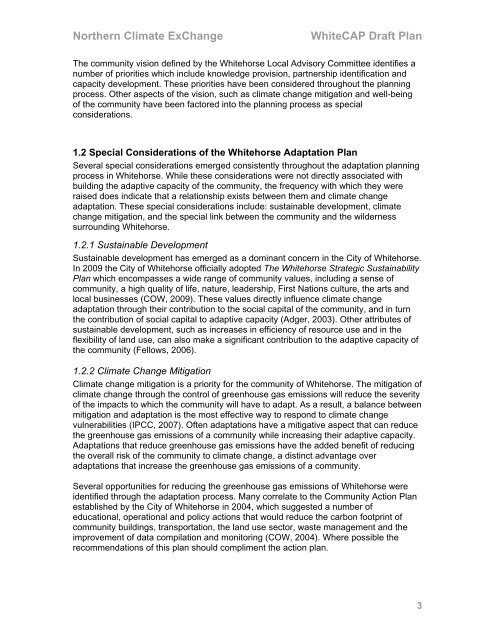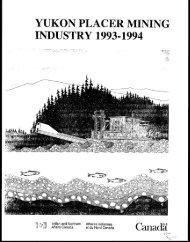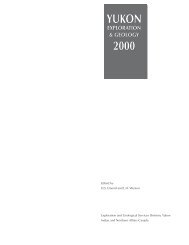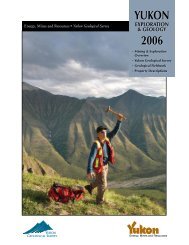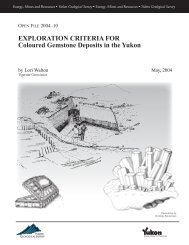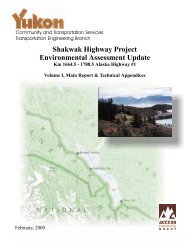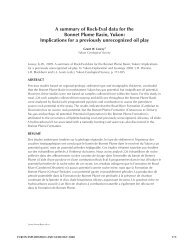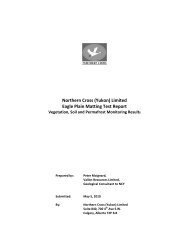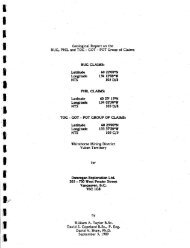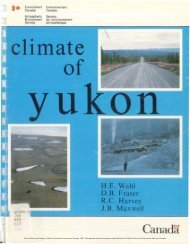WhiteCAP_Plan_01SEPT..
WhiteCAP_Plan_01SEPT..
WhiteCAP_Plan_01SEPT..
Create successful ePaper yourself
Turn your PDF publications into a flip-book with our unique Google optimized e-Paper software.
Northern Climate ExChange <strong>WhiteCAP</strong> Draft <strong>Plan</strong><br />
The community vision defined by the Whitehorse Local Advisory Committee identifies a<br />
number of priorities which include knowledge provision, partnership identification and<br />
capacity development. These priorities have been considered throughout the planning<br />
process. Other aspects of the vision, such as climate change mitigation and well-being<br />
of the community have been factored into the planning process as special<br />
considerations.<br />
1.2 Special Considerations of the Whitehorse Adaptation <strong>Plan</strong><br />
Several special considerations emerged consistently throughout the adaptation planning<br />
process in Whitehorse. While these considerations were not directly associated with<br />
building the adaptive capacity of the community, the frequency with which they were<br />
raised does indicate that a relationship exists between them and climate change<br />
adaptation. These special considerations include: sustainable development, climate<br />
change mitigation, and the special link between the community and the wilderness<br />
surrounding Whitehorse.<br />
1.2.1 Sustainable Development<br />
Sustainable development has emerged as a dominant concern in the City of Whitehorse.<br />
In 2009 the City of Whitehorse officially adopted The Whitehorse Strategic Sustainability<br />
<strong>Plan</strong> which encompasses a wide range of community values, including a sense of<br />
community, a high quality of life, nature, leadership, First Nations culture, the arts and<br />
local businesses (COW, 2009). These values directly influence climate change<br />
adaptation through their contribution to the social capital of the community, and in turn<br />
the contribution of social capital to adaptive capacity (Adger, 2003). Other attributes of<br />
sustainable development, such as increases in efficiency of resource use and in the<br />
flexibility of land use, can also make a significant contribution to the adaptive capacity of<br />
the community (Fellows, 2006).<br />
1.2.2 Climate Change Mitigation<br />
Climate change mitigation is a priority for the community of Whitehorse. The mitigation of<br />
climate change through the control of greenhouse gas emissions will reduce the severity<br />
of the impacts to which the community will have to adapt. As a result, a balance between<br />
mitigation and adaptation is the most effective way to respond to climate change<br />
vulnerabilities (IPCC, 2007). Often adaptations have a mitigative aspect that can reduce<br />
the greenhouse gas emissions of a community while increasing their adaptive capacity.<br />
Adaptations that reduce greenhouse gas emissions have the added benefit of reducing<br />
the overall risk of the community to climate change, a distinct advantage over<br />
adaptations that increase the greenhouse gas emissions of a community.<br />
Several opportunities for reducing the greenhouse gas emissions of Whitehorse were<br />
identified through the adaptation process. Many correlate to the Community Action <strong>Plan</strong><br />
established by the City of Whitehorse in 2004, which suggested a number of<br />
educational, operational and policy actions that would reduce the carbon footprint of<br />
community buildings, transportation, the land use sector, waste management and the<br />
improvement of data compilation and monitoring (COW, 2004). Where possible the<br />
recommendations of this plan should compliment the action plan.<br />
3


